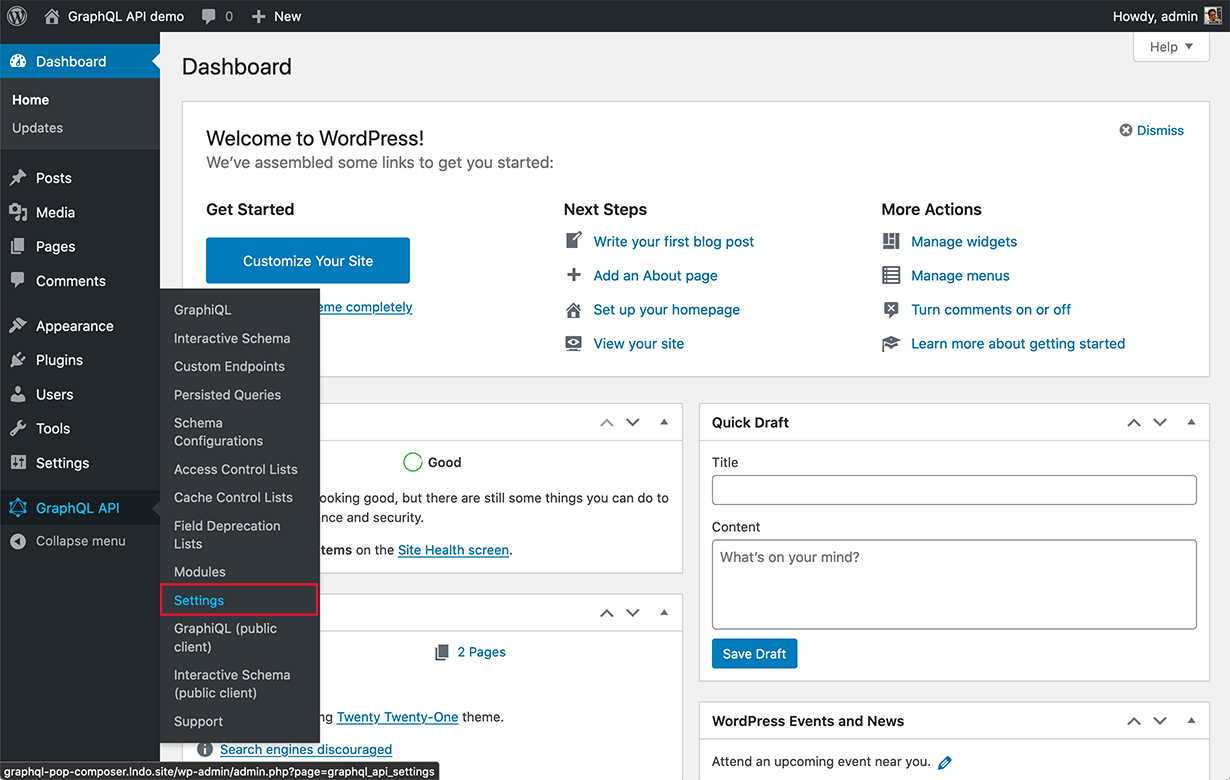Configuring the plugin via the Settings page, environment variables, wp-config, and hooks
There are several ways to configure the options in the plugin.
The Settings page
The Settings page enables to configure the plugin in the WordPress admin.
To open it, click on link "Settings" on the plugin's menu:

The settings are organized by tabs, where every tab corresponds to a module:

After updating an option, click on button Save Changes to store and apply the new value.
By environment variables and wp-config constants
All the options from the Settings page can also be set via environment variables, and constants defined in the wp-config.php file.
The priority to choose the option value from, is the following:
- If there is the corresponding environment variable, it is used
- If there is the corresponding constant defined in
wp-config.php, it is used - Otherwise, the value from the Settings page is used
After adding or modifying an environment value or wp-config constant, the plugin configuration must be regenerated. For that, go to the Settings page, and click on Save Changes.
Environment variables
| Module | Option | Environment value |
|---|---|---|
| Schema Editing Access | Editing Access Scheme | EDITING_ACCESS_SCHEME |
| Single Endpoint | Endpoint Path | GRAPHQL_API_ENDPOINT |
| Custom Endpoints | Endpoint Path | ENDPOINT_SLUG_BASE |
| Persisted Queries | Endpoint Path | PERSISTED_QUERY_SLUG_BASE |
| Graphiql For Single Endpoint | Client Path | GRAPHIQL_CLIENT_ENDPOINT |
| Interactive Schema For Single Endpoint | Client Path | VOYAGER_CLIENT_ENDPOINT |
| Public Private Schema | Mode | USE_PRIVATE_SCHEMA_MODE |
| Public Private Schema | Enable Granular | ENABLE_INDIVIDUAL_CONTROL_FOR_PUBLIC_PRIVATE_SCHEMA_MODE |
| Schema Namespacing | Use Namespacing | NAMESPACE_TYPES_AND_INTERFACES |
| Nested Mutations | Enable Nested Mutations | ENABLE_NESTED_MUTATIONS |
| Nested Mutations | Disable redundant root type fields | DISABLE_REDUNDANT_ROOT_TYPE_MUTATION_FIELDS |
| Cache Control | Default Max Age | DEFAULT_CACHE_CONTROL_MAX_AGE |
| Schema Posts | List Default Limit | POST_LIST_DEFAULT_LIMIT |
| Schema Posts | List Max Limit | POST_LIST_MAX_LIMIT |
| Schema Posts | Add Type To Custom Post Union Type | ADD_POST_TYPE_TO_CUSTOMPOST_UNION_TYPES |
| Schema Users | List Default Limit | USER_LIST_DEFAULT_LIMIT |
| Schema Users | List Max Limit | USER_LIST_MAX_LIMIT |
| Schema Tags | List Default Limit | TAG_LIST_DEFAULT_LIMIT |
| Schema Tags | List Max Limit | TAG_LIST_MAX_LIMIT |
| Schema Pages | List Default Limit | PAGE_LIST_DEFAULT_LIMIT |
| Schema Pages | List Max Limit | PAGE_LIST_MAX_LIMIT |
| Schema Pages | Add Type To Custom Post Union Type | ADD_PAGE_TYPE_TO_CUSTOMPOST_UNION_TYPES |
| Schema Custom Posts | List Default Limit | CUSTOMPOST_LIST_DEFAULT_LIMIT |
| Schema Custom Posts | List Max Limit | CUSTOMPOST_LIST_MAX_LIMIT |
| Schema Custom Posts | Use Single Type Instead Of Union Type | USE_SINGLE_TYPE_INSTEAD_OF_CUSTOMPOST_UNION_TYPE |
wp-config constants
The name of the constant in the wp-config.php file is the same as the environment variable, prepending it with GATOGRAPHQL_.
For instance, environment variable EDITING_ACCESS_SCHEME must be defined as GATOGRAPHQL_EDITING_ACCESS_SCHEME in wp-config.php.
Via hooks
We can override the value of an option via a hook.
Every option triggers its own hook:
use PoP\ComponentModel\ComponentConfiguration\ComponentConfigurationHelpers;
$hookName = ComponentConfigurationHelpers::getHookName(
$componentConfigurationClass,
$envVariable
);
add_filter($hookName, 'myFunctionToOverrideSettingsValue', PHP_INT_MAX);To obtain the hook name, we need to provide:
$componentConfigurationClass: TheComponentConfigurationclass from the package, where the option is defined$envVariable: The name of the environment variable to set
Please check an example on setting a hook.
